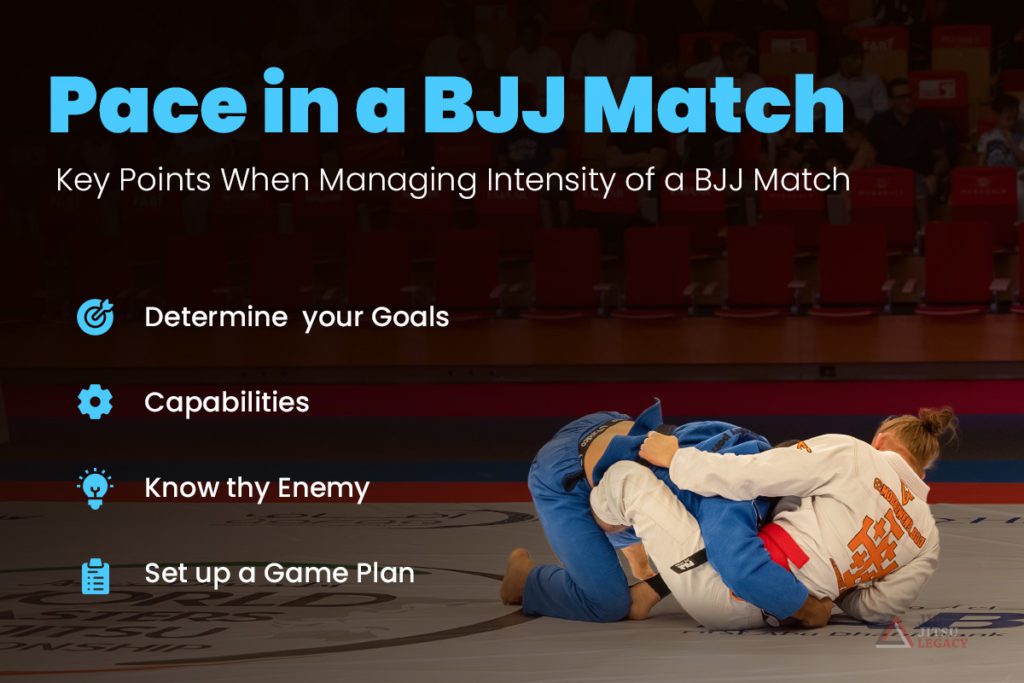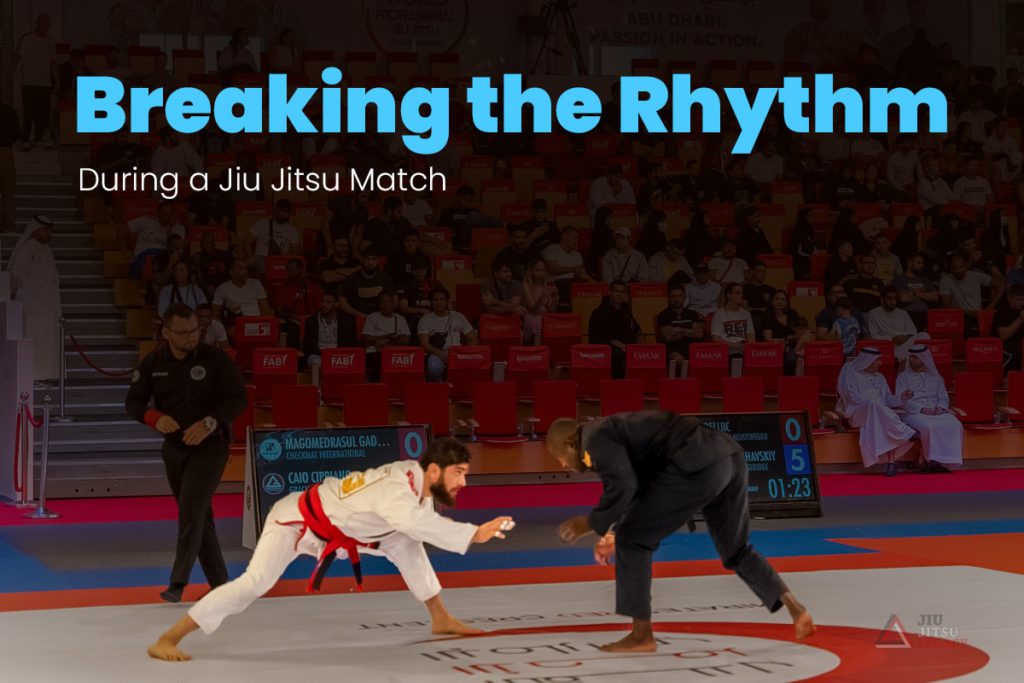Competing in a BJJ match is an experience like no other. It will put you under a different kind of stress than rolling and demand more from you physically and mentally than anything else you’ve ever done. If you can keep your mind calm during a match, you will have the upper hand in decision-making, which beats any tactical or technical preparation.
The Demands of a BJJ Match

Doing a BJJ match, our bodies and minds must work at near-maximal capacities and cooperate. This is no easy feat and is often why we fall short during our performances on the mats.
Many other factors play a role in the outcome of a BJJ match, but understanding what such an event requires from our bodies is the first step to dialing in an approach that will take into account all those factors and turn the tides to our advantage.
From a physical standpoint, we need conditioning a lot more than we need strength. Not many things in Brazilian Jiu Jitsu get solved by strength. On the other hand, having the ability to keep on grappling makes all the difference when two fighters are at a similar technical level.
You can develop crazy amounts of conditioning if you understand energy systems and can devote hours of training to grappling it. Or you could decide to pace yourself and control the intensity of any BJJ match.
Mentally speaking, you need a calm mind when you are fighting. A BJJ match will pose many questions and problems you’ll need to answer and solve under pressure with time running out. A calm mind means that your decisions will be based on logic rather than panic.
Once again, pacing yourself and finding the best rhythm for you will help your decision-making as much as your gas tank.
BJJ Match Length
A crucial factor in how you approach pacing and rhythm strategies for a BJJ match is the length of that match. Brazilian Jiu Jitsu matches can last anywhere from 5 minutes to an unlimited time.
The most common match length is five minutes. This is how many white belts get under IBJJF rules and how long all white to black athletes get under UAEJJF rules. IBJJF blue, purple, brown, and black belts grapple in six, seven, eight, and ten-minute rounds.
ADCC, WNO, Polaris, EBI, and every other promotion has its own time limit on matches, or in some cases, there’s no time limit.
Whatever the situation, you will know the ruleset you’re computing under, and you will need to form your competitive pacing strategy on this more than anything else.
The demands on the body and mind are not the same in a 5-minute and 40-minute match, which must be considered.
Accordingly, how you prepare to utilize your energy and spread it throughout a BJJ match so that you perform optimally is going to change the length of the match.
How to Pace Yourself in a BJJ Match
Pacing refers to managing the intensity of a BJJ match, despite the attempts of your opponent to influence that intensity by speeding up or slowing down the match.
Pacing has to do with breathing, conditioning, and the calmness of your mind, but these are all trainable qualities. What determines the type of pacing that will best suit you has to do more with your goals, grappling capabilities, your opponent’s game, and your own game plan.

Goals
Coming out of a BJJ victorious is, of course, the ultimate goal for anyone. However, whether you win the match on points or submission, whether you spend more time in the match on top or the bottom, all fall under your goals.
Pacing for submission hunters is at a higher intensity, as “scrambles” are welcome for submission hunters, who know how to time their submission setups during transitions. When those transitions are panicky, you get scrambles.
Whoever controls the scramble’s pace shall control the outcome of the scramble, hence you need to be able to outpace your opponent in this particular area.
If you are a point grappler, you will most likely have a slower and more methodical pace, as it is not just important to win points but not concede them along the way. This means your pace can stifle the opponent’s pace and intensity and help you work toward your goal.
Playing a top game will require you to move faster, as you’ll need to keep adjusting to an opponent’s movements and look to capitalize on them.
In contrast, fighting off your back is better done slowly and methodically, without allowing the opponent to improve upon their position, given the slight advantage top people have even when they’re inside your guard.
Capabilities
Your technical capabilities and prowess will determine your goals to a great extent. Even if you’d like to be a submission hunter, for example, until you manage to string several different submission holds together, you’ll have difficulty achieving this goal.
In other words, you can be a point fighter in a BJJ match, looking to submit people when you can and switching between a point-fighting pace and a submission-hunting pace until you can get clearer sights on one of these goals.
Although the pacing is a tactical element, you should look at it as one of the technical capabilities that will help you achieve a goal and realistically determine the best goal for your level and abilities.
Know the Enemy
While it is impossible to have tape that you can study on all your opponents, especially in tournaments at white or lower colored belts, you can still see who it’s you’re facing before the BJJ match.
Even if you can’t, you can spend the first few moments of a BJJ match trying to feel out your opponent. By utilizing a smart pace that benefits you, you can lure them into trying and matching it, getting them out of their comfort and making them show their hand.
Of course, knowing the opponent you’ll be facing well beforehand will help you determine the best possible pacing strategy to beat them.
Game Plan
Another major thing to consider is your game plan. This means knowing exactly what is your go-to move from a specific position and having one (or more) such moves for any scenario you can think of.
Given that this involves submission and positions, as well as scrambles, top and bottom positions, offense, and defense, the pacing should change in relation to each of these elements.
Break the Rhythm

So, how do you figure out the best place to perform during a BJJ match? Well, through rolling, of course.
Rolling is an amazing training tool to help you learn how to calm your mind and choose an intensity of movement that benefits you and your game the most.
Once you know whether you like to work at a higher pace (more explosive, motion-based grappling) or a slower pace (methodical, controlling, pressure-focused grappling), you’ll be able to set up a game plan where you can break the pacing “rules’.
What I mean by this is switching between different rhythms during different situations, and sometimes even reversing them.
Even if an opponent is wary about pacing and is trying to lure you to their rhythm and insanity, this can throw them off so much that it scrambles their mind, allowing you to take their body into a scramble you control.
Conclusion
Keeping a calm mind and moving your body at a pace you feel comfortable at to execute your best game plan are the two main things that will determine how you perform during a BJJ match. So before you decide to do endless surrounds of battle ropes conditioning, try to solve the strategical elements of pace and rhythm first. It is easier.

Ogi is a black belt that does Jiu Jitsu full time and is very passionate about anything grappling-related.
He is also the head coach of Enso Jiu Jitsu in Macedonia and an aspiring Globetrotter.
